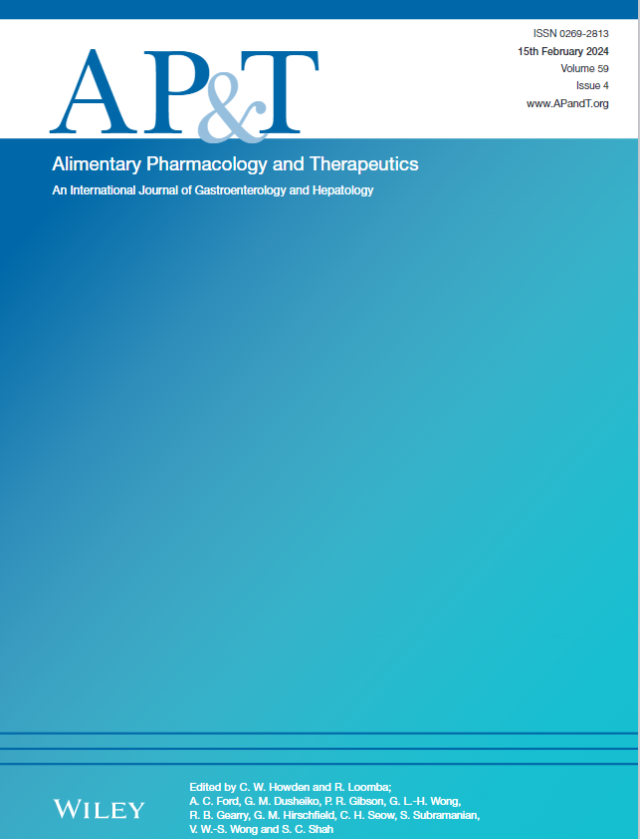慢性乙型肝炎合并代谢功能障碍或代谢功能障碍相关脂肪变性肝病患者肝细胞癌和其他肝脏相关事件的预测
IF 6.7
1区 医学
Q1 GASTROENTEROLOGY & HEPATOLOGY
引用次数: 0
摘要
慢性乙型肝炎(CHB)患者的代谢功能障碍和代谢功能障碍相关的脂肪变性肝病(MASLD)与肝细胞癌(HCC)风险增加相关。我们的目的是研究HCC的危险因素,并评估PAGE-B评分在该人群中的表现。方法我们纳入来自9个中心的伴有≥1种代谢合并症的慢性乙型肝炎患者。脂肪变性通过超声、CAP或组织学诊断。采用Cox回归分析危险因素,并在总体人群和相关亚组中评估PAGE-B评分的表现。结果纳入1922例患者。超重1730例(90.0%),高血压434例(22.6%),血脂异常254例(13.2%),糖尿病230例(12.0%),MASLD 732例(38.1%)。肝硬化、老年、低血小板和低白蛋白是HCC的独立危险因素。PAGE-B评分低/中/高的患者5年HCC风险分别为0.1%/2.0%/12.4% (p < 0.001)。MASLD患者的结果一致(低、中、高PAGE-B评分为0/2.8/11.1% (p < 0.001))。无肝硬化患者的PAGE-B分层风险(0% vs. 1.2%和1.8%,p < 0.001)。在肝硬化患者亚组中,风险分别为4.2%(低)、6.9%(中)和27.3%(高)(p < 0.001)。结论伴有代谢功能障碍和/或MASLD的schb患者发生HCC的风险较高。PAGE-B评分可用于该人群的HCC风险分层,无肝硬化且PAGE-B评分低的人群5年HCC发生率可忽略不计。然而,对于肝硬化患者,即使在PAGE-B评分较低的患者中,HCC风险仍然显著,应谨慎对待。本文章由计算机程序翻译,如有差异,请以英文原文为准。
Prediction of Hepatocellular Carcinoma and Other Liver-Related Events in Chronic Hepatitis B Patients With Metabolic Dysfunction or Metabolic Dysfunction-Associated Steatotic Liver Disease.
INTRODUCTION
Metabolic dysfunction and metabolic dysfunction-associated steatotic liver disease (MASLD) are associated with an increased risk of hepatocellular carcinoma (HCC) in patients with chronic hepatitis B (CHB). We aimed to study risk factors for HCC and to assess the performance of the PAGE-B score in this population.
METHODS
We included CHB patients with ≥ 1 metabolic comorbidity from nine centres. Steatosis was diagnosed by ultrasound, CAP, or histology. Risk factors were analysed by Cox regression, and the performance of the PAGE-B score was assessed in the overall population and across relevant subgroups.
RESULTS
We included 1922 patients. 1730 (90.0%) were overweight, 434 (22.6%) had hypertension, 254 (13.2%) dyslipidemia, 230 (12.0%) diabetes and 732 (38.1%) MASLD. Presence of cirrhosis, older age, lower platelets and lower albumin were independent risk factors for HCC. The 5-year HCC risk was 0.1%/2.0%/12.4% patients with low/intermediate/high PAGE-B scores (p < 0.001). Consistent results were obtained in patients with MASLD (0/2.8/11.1% for low, intermediate and high PAGE-B scores (p < 0.001)). PAGE-B stratified risk in patients without cirrhosis (0% vs. 1.2% and 1.8%, p < 0.001). Among the subset of patients with cirrhosis, risks were 4.2% (low), 6.9% (intermediate) and 27.3% (high) (p < 0.001).
CONCLUSIONS
CHB patients with metabolic dysfunction and/or MASLD are at significant risk of HCC. The PAGE-B score can be used to stratify HCC risk in this population, with negligible 5-year HCC incidence in those without cirrhosis and low PAGE-B scores. However, caution should be exercised in patients with cirrhosis in whom HCC risk remains significant even among those with a low PAGE-B score.
求助全文
通过发布文献求助,成功后即可免费获取论文全文。
去求助
来源期刊
CiteScore
15.60
自引率
7.90%
发文量
527
审稿时长
3-6 weeks
期刊介绍:
Alimentary Pharmacology & Therapeutics is a global pharmacology journal focused on the impact of drugs on the human gastrointestinal and hepato-biliary systems. It covers a diverse range of topics, often with immediate clinical relevance to its readership.

 求助内容:
求助内容: 应助结果提醒方式:
应助结果提醒方式:


